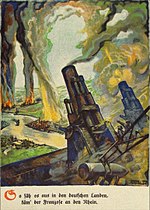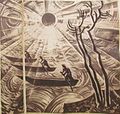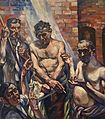Egon Tschirch
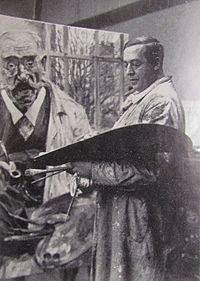
Julius Louis Hans Egon Tschirch (born June 22, 1889 in Rostock ; † February 5, 1948 there ) was a German painter and commercial artist. He is considered one of the most important artists in Mecklenburg and in 1919 was one of the founders of the Rostock Artists' Association .
life and work
Youth and education in the German Empire
From 1907 to 1912 Egon Tschirch completed the three most renowned artistic training centers in Berlin in a short time .
First he studied for two semesters at the teaching facility of the Kunstgewerbemuseum with Bruno Paul . In the winter semester of 1908, Tschirch switched to Viktor Mohn at the Royal Art School . In July 1910 he successfully passed the drawing teacher exam. From 1911 to 1912 he studied at the Royal Academy of Fine Arts with Anton von Werner . In 1913 Tschirch set up a studio in Rostock and sent for an art exhibition for the first time. The experiences of a study trip to southern France and Tunisia in 1914 were groundbreaking for the characteristic bright colors in his subsequent works.
Wounded several times as a soldier in the First World War , Tschirch made posters, leaflets and field postcards for the war press office in Berlin after his partial recovery in 1917/18. This had signed the artist for the department of pictorial propaganda . In this context there are perseverance posters, which outline allied war aims in gloomy colors and link them with corresponding texts. After the end of the war he returned to Rostock to reopen a studio there in 1918.
Artistic breakthrough in the Weimar Republic
| Boats with fishermen |
|---|
| Egon Tschirch , 1922 |
| tempera |
|
Cultural History Museum , Rostock
Link to the picture |
| Warnow fisherman |
|---|
| Egon Tschirch , 1923 |
| oil |
|
Rostock art gallery
Link to the picture |
In 1919 Egon Tschirch was one of the founding members of the progressive association of Rostock Artists, alongside Thuro Balzer , Rudolf Bartels , Walter Butzek , Bruno Gimpel and Hans Emil Oberländer .
His most important creative phase spanned the period from 1919 to the end of the 1920s . Tschirch was extremely keen to experiment and tried himself out as a painter in various styles. Expressive works by "the much admired but also much controversial Egon Tschirch" regularly gave rise to controversial discussions.
“It's no different this time, like at every Tschirch exhibition: silent and rigid individual visitors, appalled expressions in others, fleeing from the restaurant and snappy remarks even in the case of otherwise serious people. In contrast to this, again visitors who can linger for hours in the small exhibition with great pleasure and who repeatedly make their way there. "
Outstanding examples of this creative phase are the paintings "Boats with Fishermen" (1922) in the Rostock Cultural History Museum and "Warnowfischer" (1923) in the Kunsthalle Rostock .

In 1923 Tschirch created his expressionist picture cycle for the Song of Solomon . At the height of his work in 1928 he was considered to be “the strongest painter personality in Mecklenburg at the moment ”, who was compared to Oskar Kokoschka and whose pictures were juxtaposed with works by Lovis Corinth in the Schwerin State Museum .

Tschirch is also considered a master of portrait art, who was able to capture the character and traits of the portrayed extremely concisely. Several personalities of the Rostock and Mecklenburg bourgeoisie have been portrayed by him. Examples of this are the portraits “ Peter E. Erichson ” (1919), “ Max Samuel ” (1920) and twenty “Heads” (1921) with only numbers.
The equally creative graphic designer Tschirch illustrated a large number of books and developed both the first publisher Signet of Hinstorff publisher and the emblem M & O for the Rostock brewery Mahn & Ohlerich . In the years of the Great Depression, 1921–1922, he designed emergency money - the so-called Reutergeld - on behalf of Mecklenburg cities as one of five artists .
Stagnation in the time of National Socialism
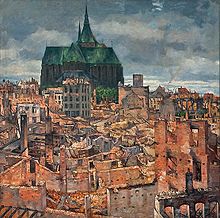
Since the early 1930s, however, there has been no further artistic development. His style - now factual and realistic - fit in well with the time. Tschirch sympathized with the rise of National Socialism and joined the NSDAP for a few years . The public perception of the painter in the Third Reich was increased through commissioned work. These contributed to the maintenance of his prosperity, but also brought the reputation of closeness to the Nazi regime.
Regardless of this, discussions arose in the summer of 1937 as to whether works from the early 1920s should be classified as " degenerate ". Advocates in the Schwerin State Museum prevented this.
In view of the almost complete destruction of his hometown in 1942, Tschirch captured the ruins of Rostock with the Marienkirche towering from them on a large-format painting. His confidence, which still existed at the beginning of the war, turned into resignation and inner distancing from the National Socialist leadership.
Last years in the Soviet occupation zone
After the end of the war in 1945 , Tschirch was able to practice painting again as a livelihood. The realism in his work was also appreciated by the Soviet victors. In addition to cityscapes, still lifes and landscapes, he now also made portraits of Soviet leaders.
Egon Tschirch died childless in 1948 at the age of 58.
reception
Since Tschirch integrated himself into both the German Empire and National Socialism , he was treated with caution in the GDR and was largely forgotten. Only in 1951 was there a memorial exhibition in the Rostock Museum. On the occasion of his 100th birthday in 1989, there was no honor.
Since the mid-1990s, Egon Tschirch's work has been increasingly noticed again. The focus of the work-up is the 1920s as the most important creative phase. In 1998 and 2015 special exhibitions took place in the Rostock Cultural History Museum . In 2016 the portrait " Max Samuel " was shown to the public again after 65 years. In 2017, for the first time since 1924, the rediscovered picture cycle of the "Song of Solomon" was exhibited in the Ahrenshoop Art Museum .
With Mechthild Mannewitz (born 1926) lives in Rostock the only artist who was a student of Egon Tschirch.
The Rostock Cultural History Museum today has the largest collection of works in Germany. Further pictures can be found in the State Museum Schwerin , in the Kunsthalle Rostock , in the Art Museum Ahrenshoop , in the German Historical Museum Berlin , in the Folkwang Museum Essen, in Leipzig and Stralsund.
gallery
500 years University of Rostock (1919)
Johannes Stelling (1924)
Publicly accessible works
- View from Mühlendamm to Nikolai and Petrikirche (undated), Rostock Cultural History Museum
- Peter E. Erichson (1919), Hinstorff Verlag
- Max Samuel (1920), Rostock Cultural History Museum ; Reproduction in the Max-Samuel-Haus Rostock
- Grandfather P. Erichson (1921), State Museum Schwerin
- Boats with fishermen (1922), Rostock Cultural History Museum
- Warnowfischer (1923), Rostock Art Gallery
- The Song of Solomon , sheet 2 & sheet 11 (1923), Kunstmuseum Ahrenshoop
- Finance Minister Hans Hennecke , caricature (1924) (reproduction), Waren / Müritz in the former Löwen pharmacy (today tourist information)
- Ecce homo - Jesus with a crown of thorns (1926), Marienkirche Rostock
- Privy Councilor Dr. Albert Peters, Director of the Eye Clinic (1932), Rostock University Eye Clinic
- Rostock from Gehlsdorfer Ufer (1936), Rostock Town Hall
- Ernst Ratschow (1937) & Clara Ratschow (1938), Rostock City Library
- Still life with flowers (1940), Käthe Kollwitz Music High School, Rostock
- The destroyed city (1942), Marienkirche Rostock
literature
- Tschirch, Egon . In: Hans Vollmer (Hrsg.): General Lexicon of Fine Artists of the XX. Century. tape 4 : Q-U . EA Seemann, Leipzig 1958, p. 478 .
- Werner Tschirch: Egon Tschirch, his life, his work; compiled from memories and documents found in the estate. new arrangement, self-published, Berlin 1974
- Ingrid Ehlers; Ortwin Pelc ; Karsten Schröder: Rostock - Pictures of a City. City views from five centuries. Reich, Rostock 1995, ISBN 3-86167-065-8 .
- Tschirch, Egon. In: Deutsche Biographische Enzyklopädie , Vol. 10, Saur, Munich [u. a.] 1999, ISBN 3-598-23170-9 , p. 107.
- Niklot Klüßendorf: Tschirch, Egon Julius Hans . in: Biographical Lexicon for Mecklenburg . Vol. 6. Schmidt-Römhild, Lübeck 2011. ISBN 978-3-7950-3750-5 . Pp. 271–275 (with portrait).
- Grete Grewolls: Who was who in Mecklenburg and Western Pomerania. The dictionary of persons . Hinstorff Verlag, Rostock 2011, ISBN 978-3-356-01301-6 , p. 10217 ff .
- Ingrid Möller: The Mecklenburg Reutergeld from 1921. Pekrul & Sohn GbR, Edition digital 2015, ISBN 978-3-95655-583-1
Web links
- Literature by and about Egon Tschirch in the catalog of the German National Library
- Literature about Egon Tschirch in the state bibliography MV
- Works by Egon Tschirch in the state bibliography MV
- Works by Egon Tschirch on artnet
Individual evidence
- ^ Archives of the Hanseatic City of Rostock: Birth Register 1889 No. 608 .
- ^ Archives of the Hanseatic City of Rostock: death register. 1948 No. 215
- ↑ From the art holdings ( Memento of the original from March 28, 2016 in the Internet Archive ) Info: The archive link was inserted automatically and has not yet been checked. Please check the original and archive link according to the instructions and then remove this notice. website Mecklenburg Foundation. Retrieved May 24, 2016.
- ↑ University archive of the Berlin University of the Arts: Egon Tschirch's curriculum vitae himself, written on May 18, 1910. In: Königliche Kunstschule - Alphabetical directory for the school year 1909/10
- ↑ University archive of the University of the Arts Berlin: Academic University of Fine Arts - alphabetical list of names of the students school year WS.1909 / 1910 – SS.1924, p. 209
- ↑ Literature: Werner Tschirch, p. 9
- ↑ Literature: Werner Tschirch, pp. 12-14
- ↑ Wolf Karge: "Künstlervereinigungen 1900-1933" in "Visual Arts in Mecklenburg 1900-1945" Hinstorff Verlag, Rostock 2010, ISBN 978-3-356-01406-8 , pp. 83-84
- ^ Mecklenburgische Zeitung Schwerin , March 4, 1922
- ↑ Mecklenburgische Warte , August 5, 1922
- ↑ Pure beauty website Urlaubsnachrichten.de. Retrieved May 16, 2016.
- ^ Kunsthalle Rostock - Collection website Kunsthalle Rostock. Retrieved August 11, 2017.
- ↑ Artmapp spring 2017: The Song of Songs in Colors , March 17, 2017, pp. 44–47
- ↑ Ernst Adolf Dreyer: Low German Monthly Issues 1928, pp. 291–296
- ↑ Mecklenburger Warte , April 10, 1921
- ^ Max Samuel in Rostock website Kulturhistorisches Museum Rostock. Retrieved January 4, 2017.
- ↑ Literature: Werner Tschirch, p. 26
- ↑ Literature: Ingrid Möller, pp. 20/364
- ↑ Marcus Pfab: Rostock Art of the 1920s to 40s - Between Traditionalism and Moderate Modernism. State examination thesis University of Greifswald - Diploma thesis agency, 1998, ID 929, p. 39
- ^ Archives of the Hanseatic City of Rostock , January 15, 1948, 1.2.0-1388 sheet 285: Personnel questionnaire
- ↑ Literature: Ingrid Möller, p. 379
- ↑ "State Main Archive Schwerin": General files concerning the Mecklenburg State Museum 1929-1938 , 13./21./23. August & 8th September 1937, 5.12-7 / 1 No. 6748
- ↑ Egon Tschirch: The Destroyed City 1942 ( Memento of the original from June 15, 2008 in the Internet Archive ) Info: The archive link was automatically inserted and not yet checked. Please check the original and archive link according to the instructions and then remove this notice. website Friends of the “Stiftung St. Marien Church in Rostock e. V. "Retrieved May 16, 2016.
- ↑ Literature: Werner Tschirch, p. 42
- ^ Antje Krause, Hans-Jürgen Mende: New Rostock Cemetery. Part 1, Hanseatic City of Rostock, Press and Information Office (Ed.) 2012, ISBN 978-3-00-036945-2 , pp. 36–37
- ↑ Literature: Ingrid Möller, p. 379
- ↑ Exhibition directory ( Memento of the original from January 22, 2017 in the Internet Archive ) Info: The archive link has been inserted automatically and has not yet been checked. Please check the original and archive link according to the instructions and then remove this notice. website Kulturhistorisches Museum Rostock. Retrieved January 18, 2017.
- ^ Ostsee-Zeitung , September 16, 2016: Max Samuel comes home
- ^ Exhibition The Song of Solomon, Website Kunstmuseum Ahrenshoop. Retrieved August 11, 2017.
- ^ Exhibition Mechthild Mannewitz website Rostock-heute. Retrieved January 18, 2017.
- ↑ Rostock's almost forgotten son website that was Rostock - Internet newspaper for the Hanseatic city, August 8, 2013. Accessed on May 16, 2016.
| personal data | |
|---|---|
| SURNAME | Tschirch, Egon |
| ALTERNATIVE NAMES | Tschirch, Julius Louis Hans Egon (full name) |
| BRIEF DESCRIPTION | German painter |
| DATE OF BIRTH | June 22, 1889 |
| PLACE OF BIRTH | Rostock |
| DATE OF DEATH | February 5, 1948 |
| Place of death | Rostock |

